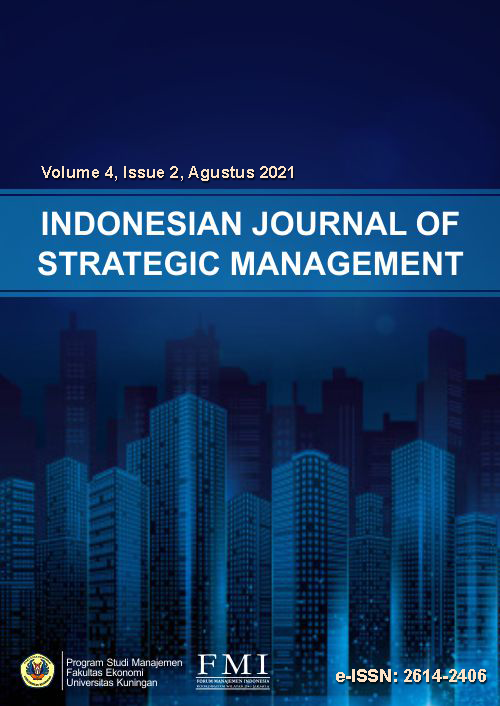Analisis Volatilitas pada Hubungan Dinamis antara Nilai Tukar, Tingkat Suku Bunga dan IHSG
Abstract
This paper investigates the dynamic relationship between exchange rate, interest rate and stock market of Indonesia from 2008 to 2017. We estimate long memory and asymmetric volatility in dynamic correlations between these variables using the VAR, FIAPARCH and DCC approach. This study estimates the emergence of long memory and asymmetric volatility in the dynamic relationship between these variables using the VAR and FIGARCH methods. The results showed that there was a strong indication of long memory and asymmetric volatility in all the volatility of the observed data. Asymmetric volatility for unexpected news in Negative results for the foreign exchange and bond markets. Positive shocks for foreign exchange and bond markets will trigger negative sentiment. In addition, the dynamic relationship between the bond market and the stock market is always found to be in a negative correlation. Positive results were obtained on bonds and exchange rates which were the same findings as in other developing countries. While the JCI showed positive results, volatility was more influenced by negative shocks than positive shocks for the stock market. Volatility shift in stock return is estimated using multiple breakpoints. The shift in volatility upwards externally was not caused by Indonesia's global political-economic financial condition. The finding from the analysis of the volatility model is that the presence of shocks in volatility causes abrupt changes in dynamic relationships whose effects are only in the short term.References
Andrieș, A.M., Căpraru, B., & Tiwari, A.K. (2017). The relationship between exchange rates and interest rates in a small open emerging economy: The case of Romania. Economic Modelling, 67, 261–274.
Bai, J., & Perron, P. (1998). Estimating and testing linear models with multiple structural changes. Econometrica, 66, 47–78.
Bai, J., & Perron, P. (2003a). Computation and analysis of multiple structural change models. Journal of Applied Econometrics, 6, 72–78.
Bai, J., & Perron, P. (2003b). Critical values for multiple structural change tests. Econometrics Journal, 18, 1–22.
Baillie, R, T,. Cecen, A, A,. Han, Y. (2000). High Frequency Deutsche Mark-US Dollar Returns: FIGARCH Representations and Non Linearities. Multinational Finance Journal, 2000, vol. 4, no. 3&4, pp. 247–267
Bautista, C.C. (2003). Interest rate-exchange rate dynamics in the Philippines: a DCC analysis. Applied of Economic Letters. 10, 107–111.
Belkhouja, M., & Boutahary, M. (2011). Modeling volatility with time-varying FIGARCH models. Economic Modelling 28 (2011) 1106–1116
Chiang, T. C., Li, J., & Yang, S. Y. (2015). Dynamic stock–bond return correlations and financial market uncertainty. Review of Quantitative Finance and Accounting, 45, 59–88
Chiang, T.C., Jeon, B.N., & Li, H. (2007). Dynamic correlation analysis of financial contagion: evidence from the Asian Markets. Journal of International Money and Finance, 26, 1206–1228.
Connolly, R. A., Stivers, C. T., & Sun, L. (2005). Stock market uncertainty and the stock-bond return relation. Journal of Financial and Quantitative Analysis, 40(1), 161–194.
Engle, R.F. (2002). Dynamic conditional correlation: a simple class of multivariate generalized autoregressive conditional heteroskedasticity models. Journal of Business and Economic Statistics, 20, 339–350
Forbes, K. and Rigobon, R. (2000) Contagion in Latin America: Definitions, Measurements and Policy Implications, NBER Working Paper, 7885
Forbes, K.J., & Rigobon, R. (2002). No contagion, only interdependence: measuring stock market comovements. Journal of Finance, 57, 2223–2261.
Hacker, R. S., Karlsson, H. K., & Månsson, K., 2012. The relationship between exchange rate and interest rate differential: A wavelet approach. The World Economy, 35(9), 1162–1185.
Lavielle, M. (2005). Using penalized contrasts for the change-point problem. Signal Process, 85, 1501–1510.
Lavielle, M., Teyssiere, G. (2007). Adaptive detection of multiple change-points in asset price volatility. In: Teyssiere, G., Kirman, A.P. (Eds.), Long Memory in Economics. Springer Berlin, Heidelberg.
Lin, F-L., Yang, S-Y., Marsh, T., & Chen, Y-F. (2017). Stock and bond return relations and stock market uncertainty: Evidence from wa velet analysis. International Review of Economics and Finance, 1-10.
Mensi, W., Hammoudeh, S., & Yoon, S.M. (2014). Structural breaks and long memory in modeling and forecasting volatility of foreign exchange markets of oil exporters: The importance of scheduled and unscheduled news announcements. International Review of Economics and Finance, 30, 101–119.
Sachs, J., Tornell, A., & Velasco, A. (1996). Financial crises in emerging markets: the lessons from 1995. Brookings Papers on Economic, Activity 1, 146-215.
Sensoy, A., Sobaci, C., & Elsevier. (2014). Effect of Volatility Shock on the Dynamic Linkage Between Exchange Rate, Interest Rate and the Stock Market: The Case of Turkey. Economic Modelling, 448-457.
Sensoy, A., Soytas, U., Yildirim, I., & Hacihasanoglu, E. (2014). Dynamic relationship between Turkey and European countries during the global financial crisis. Economic Modelling, 290-298.
Shi, Yanlin & Ho, Kin-Yip, 2015. "Modeling high-frequency volatility with three-state FIGARCH models," Economic Modelling, Elsevier, vol. 51(C), pages 473-483.
Tayefi, M., & Ramanathan, T. (2016). An Overview of FIGARCH and Related Time Series Models. Austrian Journal of Statistics, 41(3), 175–196. https://doi.org/10.17713/ajs.v41i3.172
Tsai, I.C. (2012). The relationship between stock price index and exchange rate in Asian markets: A quantile regression approach, Journal of International Financial Markets, vol. 22, 3, 609-621.
Tse, Y. K. (1998). The conditional heteroskedasticity of the yen-dollar exchange rate. Journal of Applied Economics. 13, 49–55.

